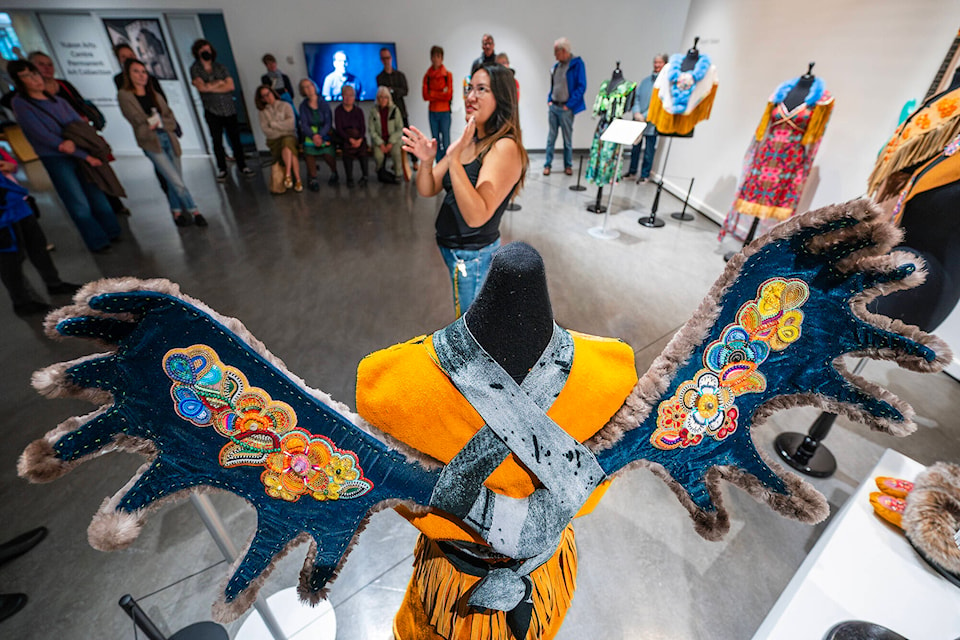Kaylyn Baker didn’t know what to say on Sept. 16 when she was announced as the recipient of the $20,000 Yukon Prize for Visual Arts. The audience in attendance for the announcement certainly did, though. The entire Yukon Arts Centre (YAC) stood to cheer for Baker, a Northern Tutchone and Tlingit artist and a citizen of Selkirk First Nation.
She is the second recipient of the bi-annual prize, which was established in 2021 by Julie Jai and David Trick.
Baker was one of six finalists up for the prize this year. Work from all six artists is currently on display in the main gallery at YAC until Nov. 18.
“We both knew [Kaylyn] a little bit from before she applied,” Trick told the News on Sept. 19.
Jai said she met Baker nine years ago, around the time Baker first started beading. Baker was at the Adäka Cultural Festival with her mother, artist Charlene Baker.
“I was super impressed by the work they were doing,” said Jai. “I looked at it, and I thought, ‘Wow, this is like taking Yukon traditional beading, but taking it to a whole new level’ […] I thought she would be someone to watch.”
The jury for the Yukon Prize agreed.
This year, the jury was made up of Sarah Milroy, chief curator at the McMichael Canadian Art Collection in Kleinburg, Ontario; Heather Igloliorte, the university research chair in circumpolar Indigenous arts at Concordia University in Montreal; and Michelle Jacques, currently the head of exhibitions and collections and chief curator at Remai Modern in Saskatoon.
In a statement emailed to the News on Sept. 19, Milroy said Baker’s work touched all three jurors.
“Both because of her almost devotional commitment to making, and because of the way she embeds personal history, story and place in her art,” the statement read. “She is definitely a young one to watch, and we were thrilled to have this opportunity to help her on her way.”
Jai and Trick hope the prize money will allow Baker to continue to push her artistry. Jai said it can be tough, when you make commercial work like Baker’s cuffs and earrings, to take a break from making the pieces that pay the bills and focus on developing her vision through work like what’s currently on display at YAC — work that was the result of a grant from the Canada Council for the Arts.
“I’m so excited to see what she’ll do,” Jai said.
She’s also excited to keep an eye on the five runners-up for the prize. They include Dawson City artists Jeffrey Langille and Rebekah Miller; Cole Pauls, a Tahltan artist and Champagne and Aishihik citizen from Haines Junction; and Whitehorse artists Omar Reyna and Alainnah Whachell. Each of the finalists received $3,000.
This shortlist was whittled down earlier this year from a long list that included Yukon artists Justin Apperley, Robyn McLeod, Meshell Melvin, Jackie Olson, Nicole Rayburn and Rosemary Scanlon.
All six finalists were in attendance at the gala event. The evening featured food, champagne and performances from Matthew Lien, the Kwanlin Dághàłaan K’e Dancers, and Bria Rose N’ Thorns.
It was the finale to three days of arts programming associated with the prize. There was an opening for the Yukon prize exhibition at YAC on Sept. 14; an art crawl through 19 arts venues and galleries in Whitehorse on Sept. 15; and a series of panels, tours and workshops before the gala on Sept. 16.
This was the first year the prize was able to be celebrated properly. COVID-19 restrictions in its inaugural year, 2021, meant events had to be cancelled, and the announcement was scaled back. Because Yukoners had no prior experience with prize festivities, Trick and Jai said they didn’t know what kind of numbers the events would attract. However, attendance was high all week, culminating in more than 200 people at the gala.
“The goal for this year, in addition to the prize, was to have a Yukon Prize weekend that would be significant and attract many people,” said Trick. “Big enough to attract people from Outside [including Michelle LaVallee, director of Indigenous ways and decolonization with the National Gallery of Canada, who did attend]. Speaking personally, I couldn’t be happier with how it’s worked out.”
Baker was not available for an interview before this story went to print.
Contact Amy Kenny at amy.kenny@yukon-news.com
